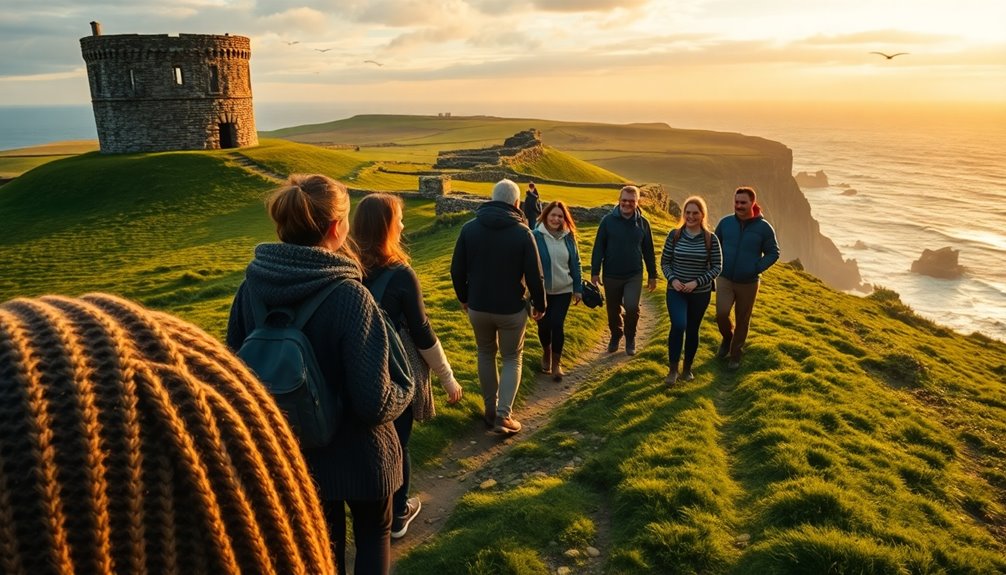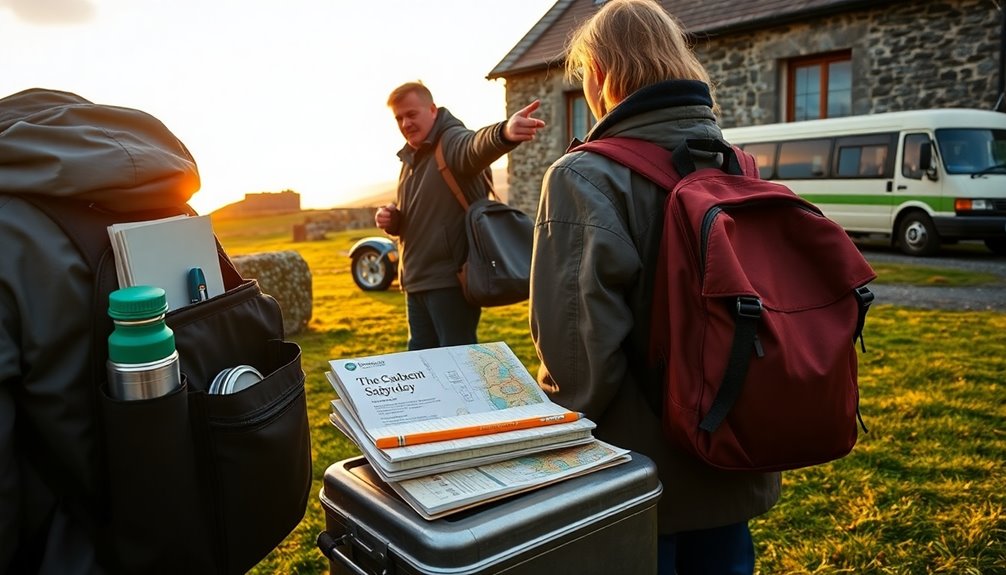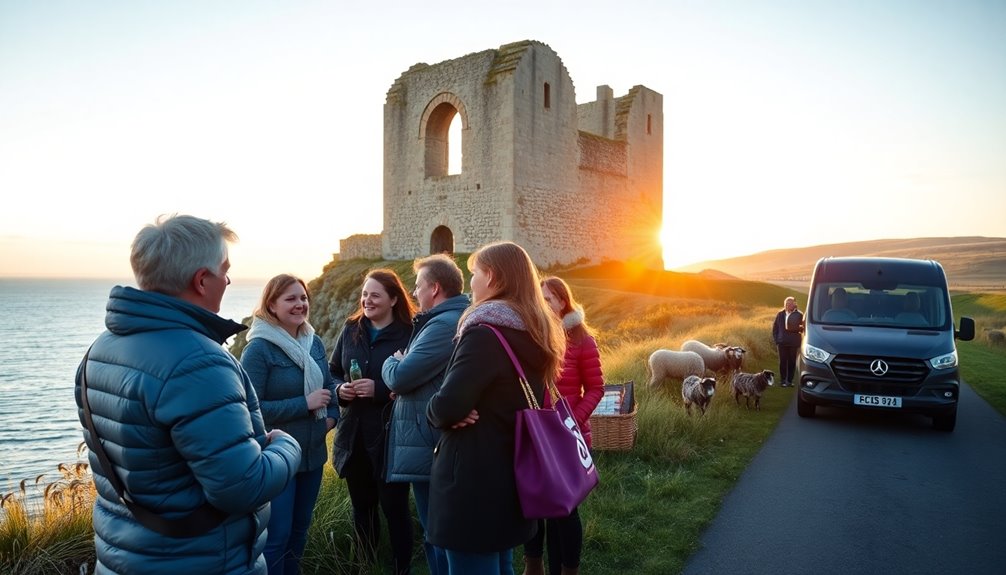
You’ll get more from Irish history tours that combine Gaeltacht stays with urban language schools, hidden alleys, rebel sites and storytelling walks. Choose small groups and local guides so you can practice Irish in markets, pubs and fortresses like Dún Aonghasa or Glendalough. Add music, céilí and bodhrán sessions to build rhythm and vocabulary. Pick flexible itineraries with accessible options for families and elders. Keep going to find practical schedules, packing tips and booking advice.
Getting the Most From Historical Walking Tours
Want to get more from a historical walking tour? You’ll want to move beyond dates and plaques and tap into historical storytelling that sparks curiosity and autonomy. Let guides know you prefer routes that reveal hidden alleys, rebel sites, and everyday lives—places that let you choose what resonates. Ask for anecdotes that link past struggles to present freedoms so you can feel the throughline of change. Seek tours emphasizing cultural connections: folk songs, languages, customs that show how people lived and resisted. Carry a small notebook, question assumptions, and follow your impulses to linger where something clicks. By shaping the pace and topics, you’ll turn a guided walk into a personal exploration of Irish history and identity.
Choosing Gaeltacht and Urban Language Immersion Options
Looking for the best way to improve your Irish? You’ll choose between Gaeltacht experiences and urban immersion depending on how free you want to schedule learning. If you crave natural speech, rural Gaeltacht experiences drop you into daily life—markets, pubs, community classes—where language grows organically and you’re invited to join. If you value flexibility and variety, urban immersion in cities offers structured schools, pop-up conversation groups, and cultural events you can slot around tours. Mix both if you like: intensive weekends in a Gaeltacht, weekday classes in town. Look for programs that respect your independence—self-directed study time, optional excursions, and conversational goals rather than rigid curricula—to keep learning lively and aligned with your roaming spirit.
Key Historical Sites to Combine With Irish Lessons
You can boost your Irish lessons by visiting major Gaelic strongholds like Dún Aonghasa or sites in the west where the language and traditions are still alive. Pair those with urban historical sites—Dublin’s medieval quarter or Galway’s Spanish Arch—to contrast rural Gaelic culture with city history. Combining both settings will give you richer context and more authentic language practice.
Major Gaelic Strongholds
When you pair Irish lessons with visits to major Gaelic strongholds, the language comes alive amid castles, ringforts, and monastic sites that shaped Gaelic society. You’ll feel Gaelic heritage in stone and landscape, and lessons will deepen your sense of cultural significance as you walk battlements and cloisters. You want freedom to explore, ask questions, and speak without fear.
- Dún Aonghasa — practice phrases while touring a cliff-top ringfort, imagining original Gaelic life.
- Grianán of Aileach — use conversational Irish near royal ruins, linking words to power and place.
- Glendalough monastic sites — combine quiet language drills with history that shaped faith and community.
Each site frees your speech and roots vocabulary in real, resonant histories.
Urban Historical Sites
Though urban streets hum with modern life, city historical sites offer rich, accessible contexts to practice Irish amid architecture, markets, and memorials. You’ll roam lanes of medieval architecture, learn vocabulary at bustling markets, and swap urban legends with locals while tasting freedom to explore at your own pace. Use short Irish phrases for directions, signage, and storytelling at plaques and squares. Pair lessons with self-guided prompts: describe a façade, ask for directions, or recount a legend. Here’s a quick visual guide to match sites with language goals:
| Site type | Language focus |
|---|---|
| Castle courtyards | Past tense storytelling |
| Market stalls | Transactional phrases |
| Memorials | Formal vocabulary |
| Alleyways | Directions & slang |
| Museums | Historical terms |
Scheduling Workshops and Live Demonstrations
When you plan workshops, think about timing so sessions fit between site visits and keep energy high. For live demonstrations, coordinate setup, sound, and safety with guides and presenters ahead of time. Build brief buffers into the schedule to handle overruns or quick Q&A.
Workshop Timing Strategies
Because your audience’s energy and attention ebb and flow during a tour day, schedule workshops and live demonstrations at moments that match those peaks—think morning focus after arrival and early afternoon lulls for hands-on activities—to maximize engagement and learning. You’ll want workshop formats that feel freeing and varied, and you’ll build timing flexibility into the schedule so people can opt into depth or quick samples. Keep sessions concise, offer clear rest or free-time windows, and signal shifts so participants stay relaxed and in control.
- Start with focused, shorter sessions when attention is high to introduce concepts.
- Use mid-day hands-on workshops for movement and practice during lulls.
- Offer optional evening roundups or informal language chats for free-choice engagement.
Live Demo Logistics
You’ve timed workshops to match energy peaks, now plan the practical details that make live demos run smoothly: set clear start and end times, assign a facilitator to keep pace, and choose demo lengths that match attention windows you’ve already mapped. You’ll want simple live demonstration strategies that respect participants’ autonomy — offer optional join points, short Q&A breaks, and choices between immersive or observational roles. Cover logistical considerations like reliable AV, backup plans for outdoor shifts, and clear meeting points so people can come and go without feeling trapped. Share concise prep notes beforehand, label materials for self-service, and train facilitators to signal shifts. That way your demos feel freeing, efficient, and firmly under control.
Engaging With Local Storytellers and Historians
Curious who really brings Ireland’s past to life? You will, when you seek out local storytellers and historians who blend storytelling techniques with rigorous historical accuracy. Meet them in pubs, libraries, or ruins; they’ll invite you to question, debate, and feel free to challenge received narratives. You’ll practice language skills as you listen and respond, gaining nuance and confidence.
- Attend a county historian’s talk — get precise dates, sources, and spirited local context.
- Join a seanchaí session — absorb oral storytelling techniques and lively dialects.
- Arrange a one-on-one walk — discuss contested events, ask for primary-source tips, and shape your own understanding.
Practical Packing and Travel Tips for Immersion Trips

A few smart choices will keep you comfortable, flexible, and ready for whatever an immersion trip throws at you: think layered clothing for unpredictable weather, sturdy shoes for uneven terrain, a compact rain jacket, and a daypack organized with a water bottle, portable charger, and a small notebook for names, phrases, and directions. Pack light but intentionally: toiletries, quick-dry layers, a travel umbrella, plug adapter, and copies of important documents. Prioritize packing essentials that let you move freely and join spontaneous village walks or museum stops. Learn basic phrases before you go, charge devices nightly, and keep digital backups of IDs. Buy travel insurance that covers health and delays so you can roam without worry and embrace the trip.
Participatory Activities: Music, Dance, and Oral Traditions
When you join an Irish music session, céilí, or storytelling circle, you’ll find participation isn’t just welcome—it’s central: clapping, joining a tune on a bodhrán or fiddle, stepping into a set dance, or sharing a tale helps you connect with community rhythms and local memory. You’ll be invited to try traditional music by ear, learn a reel or polka, and immerse in cultural dances that free movement and voice. Expect gentle guidance, encouragement, and moments where improvisation feels natural. These gatherings let you practice language, loosen up, and claim space in living traditions.
Join a session—clap, play, dance, or tell a tale; participation is how tradition lives.
- Try a bodhrán beat — rhythm teaches phrasing and pace.
- Learn a céilí step — movement opens social exchange.
- Tell or listen to a short seanchaí tale — stories teach local truth.
Accessible and Family-Friendly Tour Considerations
Joining a music session or céilí is great for all ages, but you’ll also want to know how tours and activities fit different needs before you book. You’ll appreciate clear info on family friendly accommodations—look for flexible rooming, kid-focused program notes, and dining that eases picky eaters. Seek guides who adapt pacing and content so kids and elders both stay engaged without feeling rushed. Confirm accessible transportation options ahead of time: wheelchair ramps, low-floor coaches, and space for strollers make moving between sites straightforward. Ask about venue accessibility, quiet areas for breaks, and sensory-friendly timing if you or your kids need it. Choosing tours that respect mobility and family rhythms lets you roam freely and fully enjoy Ireland.
Booking, Group Sizes, and Responsible Tourism Practices

Because tour size and booking details shape your experience, pick operators who clearly state group limits, cancellation policies, and what’s included so you’re not surprised. You’ll want freedom to explore and flexible booking policies that let you adjust plans without penalty. Consider how group dynamics affect pacing, conversation, and opportunities to practice language; smaller groups usually give you more authentic interaction. Look for tours that commit to local benefit and low-impact travel so your choices support communities.
Choose small, transparent tours with flexible booking and responsible practices to protect local communities and your experience.
- Check booking policies for deposits, refunds, and last-minute changes.
- Favor small-group or private options to control pace and immersion.
- Ask about responsible practices: local guides, sustainable transport, and cultural respect.
Some Questions Answered
Do Tours Accommodate Dietary Restrictions During Homestays?
Yes — you’ll have your dietary needs respected; hosts and coordinators work with homestay options to accommodate allergies, preferences, and restrictions. You’ll still enjoy flexible, authentic meals while keeping control over what and when you eat.
Are Private Tutor Sessions Available for Advanced Learners?
Like a tailor-made cloak, yes — you’ll get private tutoring for advanced learning, letting you shape lessons to your pace and passions. You’ll have freedom to choose topics, schedules, and intensity that suit your goals.
What Is the Cancellation and Refund Policy for Multi-Week Programs?
You can cancel within the stated cancellation terms for partial or full refunds; the refund process starts once we confirm cancellation and follows our schedule and fees. You’ll retain flexibility, and we’ll process refunds promptly.
Do Tours Offer Immersion Options in Northern Ireland?
Yes — you can choose Northern Ireland immersion options that blend local language practice with cultural experiences; you’ll explore vibrant communities, enjoy open-minded learning, and have freedom to shape your days while diving into history and traditions.
Is Travel Insurance Included or Recommended for Participants?
Of course not — except you’ll want travel insurance for participant safety, since freedom-loving travelers dislike surprise problems. You’ll be covered for delays, medical care, and cancellations, so don’t skip sensible protection before you go.
